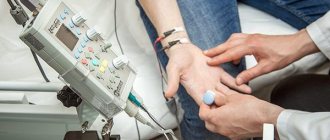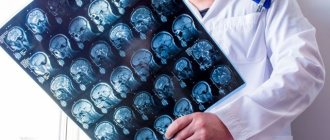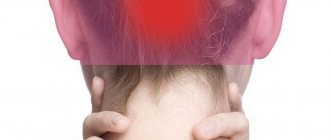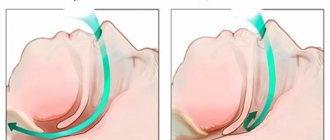My hands are going numb
Numbness is a loss of sensation in any part of the body. Numbness may be accompanied by a tingling sensation, goosebumps, burning, tightness of the skin, as well as a feeling of cold in the numb part of the body. The most common complaints are numbness of the extremities - hands (sometimes they talk about numbness of the fingers) or legs.
We perceive numbness as a loss of signal: nerve impulses from the numb area do not reach the brain. In most cases, the cause is local in nature and consists of damage to peripheral nerves or a violation of local circulation, as a result of which the nerves are deprived of the necessary nutrition. However, sometimes numbness is a symptom of a central nervous system disorder.
Physiological causes of numbness
Numbness occurs with prolonged immobility. Whatever position we are in, some vessels become pinched, and we risk that the nerve endings, which do not receive proper nutrition, will lose sensitivity. Our body must move, changing the areas that have been subjected to compression, and then we will not be in danger of numbness. This usually happens during the day. But during deep sleep, we can lie in the same position for quite a long time without changing posture. And then, when we wake up, we notice that we have rested some part of our body, for example, a hand placed under our head.
Numbness is caused by exposure to cold. When in contact with cold air, the skin loses sensitivity. Local blood circulation is disrupted, and we cease to feel the nerve endings. If this situation lasts longer, frostbite is possible, but in most cases it is enough to rub the area of skin that has lost sensitivity or return to warmth, blood circulation will be restored and the numbness will go away.
If numbness occurs without an obvious connection with a specific situation, then it probably has a pathological cause.
Treatment
To cure numbness in the arms and legs, it is advisable to go to a rehabilitation medicine clinic and consult with a specialist. The doctor will prescribe the necessary procedures depending on the cause: to improve blood circulation in the extremities, eliminate neurological disorders or the consequences of injuries. Some components of the therapeutic program affect several mechanisms of symptom occurrence at once.
Numbness in the legs and arms is treated in the following ways:
- Nutrition - the diet should contain a large amount of vitamins and minerals.
- Therapeutic gymnastics - the doctor will draw up an exercise program that must be performed 2-3 times a week.
- Massage - warming up will improve blood circulation in the legs and eliminate congestion.
- Manual therapy is prescribed according to indications for diseases of the musculoskeletal system.
- Physiotherapy - some strengthening procedures (SWT, magnetotherapy, ion therapy, laser treatment) will improve blood flow and metabolic processes, and accelerate the restoration of damaged tissues.
- Acupuncture - used to restore sensitivity in neurological disorders.
- Some medications - the doctor may prescribe ointments with a warming or cooling effect (Viprosal, Capsicam, Nicoflex, Finalgon). The action of the products is based on improving blood flow and irritating nerve endings.
Experts categorically do not recommend self-medication - home therapy brings only temporary relief. A doctor will draw up a comprehensive program aimed at eliminating the cause of numbness in the arms and legs.
Numbness as a symptom
Numbness can be caused by:
- pinched nerve. A pinched nerve can occur at the point where it exits the spinal canal ( radicular syndrome
).
Therefore, numbness is a typical symptom of osteochondrosis and other spinal diseases. The nerve can also be pinched in other areas. Pinching of a nerve in its natural canal (tunnel) is defined as tunnel syndrome
.
The most common is carpal tunnel syndrome
(a pinched nerve in the wrist).
In this case, the fingers go numb. Office work (using a keyboard and mouse) contributes to the development of the disease. Also quite common is ulnar nerve neuropathy
, the development of which is facilitated by the need for prolonged support with the elbow (typical of working at a computer).
Wearing a belt, pressing the thigh against the edge of the table, or inconvenient objects in pockets can lead to pinching of the external cutaneous nerve of the thigh ( Roth disease
) - the most common foot tunnel syndrome; - injury. Trauma can disrupt the integrity of nerve fibers, resulting in loss of sensation in the area supplied by the damaged nerve;
My legs are going numbproblems of peripheral circulation. For example, the development of atherosclerosis of the vessels of the lower extremities leads to disruption of the blood supply to the legs (primarily the feet). A lack of fresh blood flow manifests itself as pale skin, a local decrease in body temperature, and numbness. Numbness may also accompany a violation of the venous outflow of blood (chronic venous insufficiency);
- anemia (decreased hemoglobin in the blood). The reasons may be problems with the intake or absorption of iron, vitamins (B12, folic acid);
- polyneuropathy - multiple lesions of peripheral nerves. Polyneuropathy can be a consequence of diabetes mellitus, alcoholism, poisoning, long-term use of certain medications, autoimmune diseases, metabolic disorders and other systemic pathologies;
- diseases of the central nervous system - such as brain tumors, cerebrovascular accidents, multiple sclerosis.
Treatment of numbness
After diagnosis, the neurologist will select the appropriate treatment method. Our specialists use the most proven and effective methods to prevent inflammatory processes, restore blood flow and improve nutrition in tissues:
- Reflexology.
- Medical massage.
- Therapeutic physical education, kinesiotherapy.
- Manual therapy and osteopathy.
- Ozone therapy, shock wave therapy.
Depending on the suspected cause of numbness in the extremities, appropriate types of diagnostics are prescribed:
- X-ray – used for possible disorders of the spine or skull, its base.
- Angiography is used in the diagnosis of blood vessels; it is also possible to prescribe ultrasound, CT, and MRI.
If spontaneous tingling or numbness occurs in any part of the body, you should immediately contact a specialist. Ignoring such problems can lead to serious complications, causing surgery or disability. Medical specialists have more than thirty years of experience in neurology, which allows them to accurately, quickly and efficiently determine the cause of an emerging illness. Take care of your health and do not ignore your body's signals!
Make an appointment with a Neurologist
In what cases should you consult a doctor if you have numbness?
If the numbness has a physiological cause, that is, caused by a temporary disruption of the local blood supply, then it is enough to change the position and rub the numb area, and sensitivity will be restored. If the numbness does not go away, then the cause is more serious and you should consult a doctor.
It is necessary to get emergency medical help if numbness is accompanied by symptoms of damage to the central nervous system:
- headache, dizziness, attacks of weakness, double vision, loss of coordination;
- unexpected bowel movements or sudden urination;
- speech problems.
These symptoms may occur after a head, neck, or back injury.
You should also consult a doctor if:
- numbness occurs periodically and without an obvious reason;
- thermal perception is impaired (for example, the ability to distinguish between warm and cold water is impaired);
- Numbness is preceded by pain and loss of range of motion in one of the joints.
Which doctor should I contact for numbness?
Numbness is a neurological symptom, so if you complain of numbness, you should consult a neurologist. You must be prepared for the fact that a medical examination is only the first stage in solving the problem. Further instrumental studies will be required: MRI (for radicular syndrome), electroneurography, ultrasound (shows a picture of blood flow in the area under study), EEG (performed if diseases of the central nervous system are suspected). There may also be a need for laboratory tests (complete blood count, blood test for hormones, test for vitamins, etc.).
Treatment for numbness is aimed, first of all, at eliminating the cause that caused it, that is, the disease whose symptom is numbness is subject to treatment. In some cases this may require considerable time.
If you are concerned about numbness in your fingers, arms or legs in general, or any other area of the body, contact the nearest clinic of JSC “Family Doctor”. Our neurologists will determine the cause of the numbness and prescribe adequate treatment. Therapeutic activities may include physiotherapy, physical therapy, massage, reflexology, manual therapy - this entire range of services is provided in the Family Doctor JSC network. Surgical treatment is carried out in the company's high-tech Hospital Center.
Etiology
The causes of numbness of the extremities are divided into several subgroups: cardiovascular, neurological and orthopedic. In any condition, there is a disconnection between the brain and part of the arm or leg. This is perceived as a loss of sensitivity.
Cardiovascular diseases
The most common reason why arms and legs go numb is heart and vascular disease, leading to poor circulation. With insufficient blood flow, cellular nutrition deteriorates, and congestion occurs in the limbs.
Poor circulation is caused by:
- Atherosclerosis - affects large arteries and impairs blood flow.
- Thrombosis - contributes to blockage of blood vessels, which leads to poor circulation.
- Varicose veins cause stagnation of venous blood in the legs and loss of sensitivity.
- Cardiac and venous insufficiency - in both conditions, blood circulation deteriorates and loss of sensitivity occurs.
- Raynaud's syndrome - causes a narrowing of the blood vessels in the hands and feet, a feeling of coldness and "cottoniness" in the palms and soles.
- Buerger's disease affects small and medium-sized vessels, disrupting the blood supply to the hands and feet.
- Arteriovenous malformation - numbness occurs due to the congenital absence of capillaries. Their role is taken over by modified arteries and veins, partially nourishing the tissues.
Sometimes numbness in the extremities of the arms and legs appears when large arteries are compressed due to an uncomfortable posture during sleep or during physical overload.
Neurological causes
A neurologist can explain why the limbs of the arms and legs go numb - such reasons are quite common. In these conditions, the sensory centers of the brain are affected or damage to the peripheral nerves occurs.
What diseases cause numbness in arms and legs? The list of such ailments in neurology is wide:
- encephalitis;
- stroke;
- spinal cord injuries;
- oncology;
- neuropathy;
- hypothyroidism;
- poisoning;
- sclerosis;
- myelopathy;
- vitamin deficiencies;
- alcoholism.
Sometimes the cause of numbness in the limbs is pinching of large nerves by swollen tissues due to water retention in the body, which occurs in pregnant women.
Orthopedic reasons
Numbness in an arm or leg may result from damage to bones, joints, or soft tissue. Surgeons and traumatologists include such conditions:
- intervertebral hernia;
- fractures and dislocations;
- osteoporosis;
- osteochondrosis;
- carpal tunnel syndrome, sciatica;
- pinching of large nerves.
Orthopedic disorders provoke numbness of the limbs for several months. Injured patients require constant strengthening procedures.











